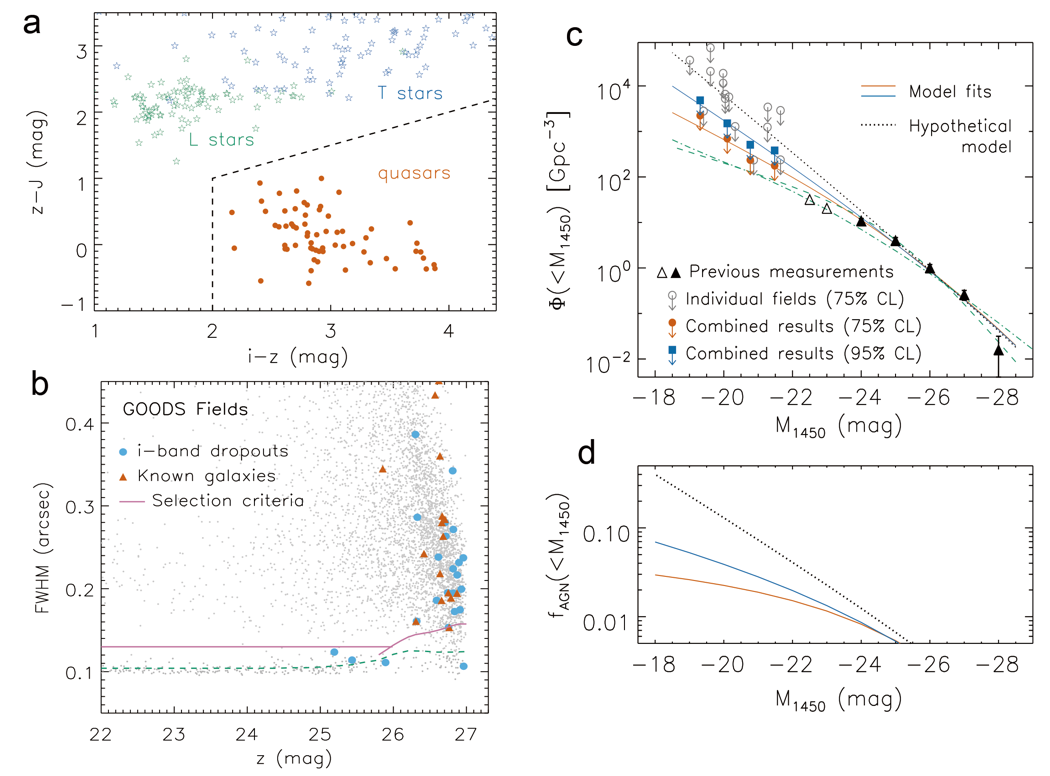A team of astronomers, led by Professor Linhua Jiang at the Kavli Institute for Astronomy and Astrophysics and School of Physics at Peking University, has revealed that distant quasars or galactic nuclei with actively growing supermassive black holes made a negligible contribution of ionizing photons to cosmic reionization 13 billion years ago. This finding settles a long-standing issue about the quasar contribution to cosmic reionization, and suggests that galaxies are the major energy sources. The result was recently published as an article in Nature Astronomy on June 16, 2022.

Figure 1. An artist’s conception of cosmic reionization occurred about 13 billion years ago (credit: Jingchuan Yu, Beijing Planetarium).
Cosmic reionization occurred several hundred million years after the Big Bang (Figure 1; current age of the universe is about 13.8 billion years). Before the era of reionization, the universe was “dark” because there were no light sources other than the cosmic background radiation. By the end of this dark age, the earliest astrophysical objects — stars, galaxies, and quasars — started to form. They emitted copious ultraviolet Lyman continuum (LyC) photons that are energetic enough to gradually ionize most of the hydrogen atoms in the intergalactic medium. This epoch of “cosmic reionization” lasted a few hundred million years and represents the most recent major phase transition of the gas in the universe. One key question is what sources produced most of the LyC photons responsible for reionization. The most obvious candidates are quasars, which are powered by active supermassive black holes, and star-forming galaxies, which contain massive stars. However, the relative balance of these two sources has been a subject of long-standing debate.
The current understanding of the contribution of stars to reionization is hampered by our limited knowledge of the fraction of LyC photons that escape from galaxies at redshift around 6 or higher, when the universe was less than a billion years old. Observations indicate that the LyC escape fraction from low- and intermediate-redshift galaxies is only a few percent on average. This means that most of the ionizing photons produced by stars are absorbed (or scattered) by the galaxies themselves or their surrounding medium. Directly detecting the LyC from high-redshift galaxies is unrealistic because of intergalactic medium absorption along the light-of-sight. For high-redshift quasars, although bright quasar samples have been established, little is known about very faint quasars that surpass in number and thus may have played an important role in providing LyC photons for reionization.
Since a direct measurement of the contribution of galaxies to reionization is unfeasible, the strategy of Jiang’s team was to directly constrain the number of LyC photons produced by quasars. The key challenge was to identify quasars that are a few tens of times fainter than the faintest quasars previously known, ones that are beyond the reach of the traditional method of spectroscopic identification even with the largest current telescopes. Jiang’s team developed a new method, one that bypassed spectroscopy, to search for extremely faint quasars at redshift between 6.0 and 6.6 by combining deep Hubble Space Telescope (HST) and ground-based images. Using multiband imaging data to separate quasar candidates from lower-redshift objects (Figure 2a), in conjunction with the high spatial resolution of HST to identify point-like objects (Figure 2b), they succeeded in identifying point objects that are presumably quasars.
Jiang’s team applied the above method to suitable archival HST images, but they failed to find any quasars at redshift between 6.0 and 6.6. The absence of observable quasars in this dataset puts a stringent upper limit on the abundance of faint quasars. Using this constraint and the abundance of bright quasars calculated by previous studies, they were able to construct the first high-redshift quasar luminosity function (abundance as a function of luminosity) that spans 10 magnitudes (factor of ten thousand; Figure 2c), and thus measure the total number of LyC photons emitted by the entire quasar population. By comparing the photon output required to ionize the universe at this redshift range, they found that quasars can only provide up to 7% (95% confidence level) of the photons required for reionization (Figure 2d). This conclusively demonstrates that quasars made a negligible contribution to cosmic reionization.

Figure 2. Quasar selection and the quasar contribution to cosmic reionization. (a) Selection of high-redshift quasar candidates using multiband imaging data. (b) Quasars were further identified using high-resolution HST imaging data. (c) Quasar luminosity function that spans 10 magnitudes. (d) The quasar contribution to cosmic reionization is less than 7%.
“The paper, in my view, carefully and thoroughly settles a long-standing issue that AGN (quasars) do not contribute significantly to cosmic hydrogen reionization,” said James Dunlop, an Astronomy professor at University of Edinburgh who was not involved with this study.
The result of Jiang’s team suggests that stars in galaxies are the primary sources of ionizing photons during the epoch of reionization if non-standard candidates are neglected. This work has indirectly solved the important astrophysical problem about the energy sources of cosmic reionization. It also helps us to better understand the reionization history and related physical processes.
This work was supported by the National Science Foundation of China and the China Manned Space Project.
Link to the paper:
Definitive upper bound on the negligible contribution of quasars to cosmic reionization
(DOI: 10.1038/s41550-022-01708-w)
https://www.nature.com/articles/s41550-022-01708-w
PKU News:
https://news.pku.edu.cn/jxky/ebe56a5a91914f30b9ed23939d1f3a93.htm